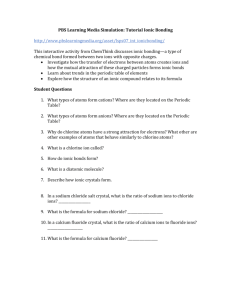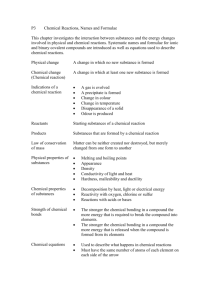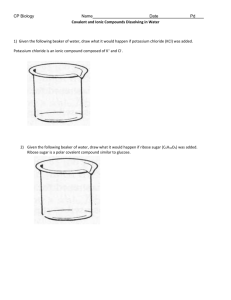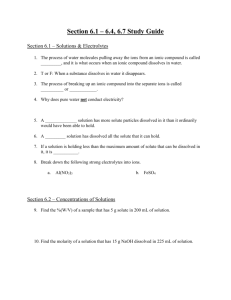Reading Chemical Formulas and Understanding - Bennatti
advertisement
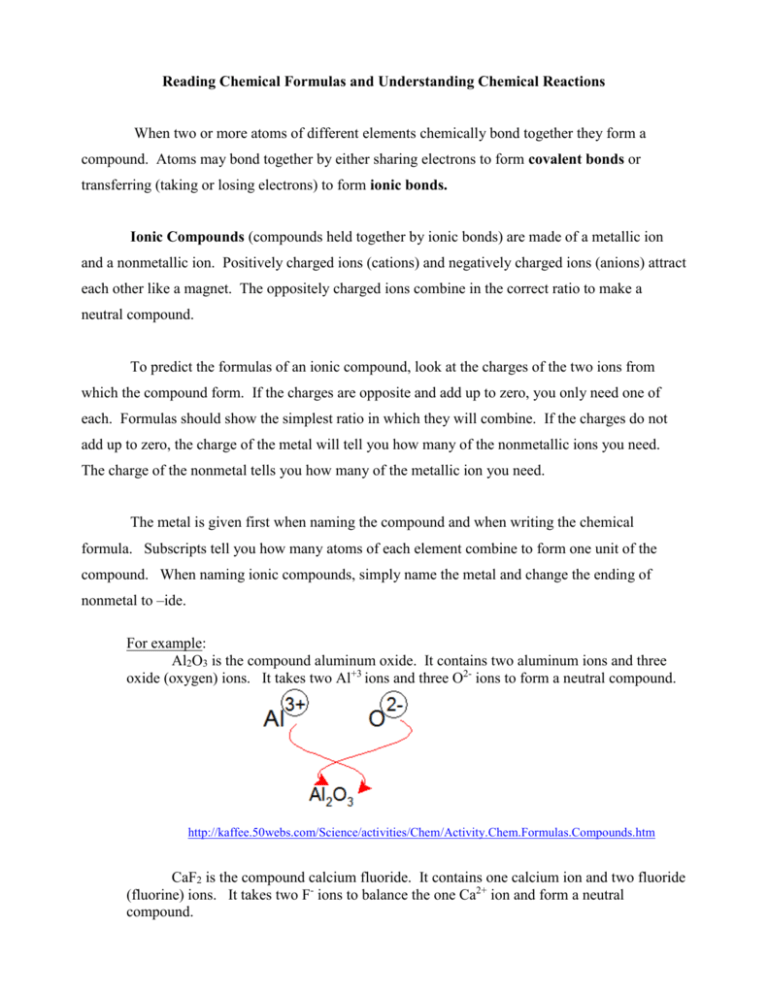
Reading Chemical Formulas and Understanding Chemical Reactions When two or more atoms of different elements chemically bond together they form a compound. Atoms may bond together by either sharing electrons to form covalent bonds or transferring (taking or losing electrons) to form ionic bonds. Ionic Compounds (compounds held together by ionic bonds) are made of a metallic ion and a nonmetallic ion. Positively charged ions (cations) and negatively charged ions (anions) attract each other like a magnet. The oppositely charged ions combine in the correct ratio to make a neutral compound. To predict the formulas of an ionic compound, look at the charges of the two ions from which the compound form. If the charges are opposite and add up to zero, you only need one of each. Formulas should show the simplest ratio in which they will combine. If the charges do not add up to zero, the charge of the metal will tell you how many of the nonmetallic ions you need. The charge of the nonmetal tells you how many of the metallic ion you need. The metal is given first when naming the compound and when writing the chemical formula. Subscripts tell you how many atoms of each element combine to form one unit of the compound. When naming ionic compounds, simply name the metal and change the ending of nonmetal to –ide. For example: Al2O3 is the compound aluminum oxide. It contains two aluminum ions and three oxide (oxygen) ions. It takes two Al+3 ions and three O2- ions to form a neutral compound. http://kaffee.50webs.com/Science/activities/Chem/Activity.Chem.Formulas.Compounds.htm CaF2 is the compound calcium fluoride. It contains one calcium ion and two fluoride (fluorine) ions. It takes two F- ions to balance the one Ca2+ ion and form a neutral compound. Mg3P2 is the compound magnesium phosphide. It contains three magnesium ions and two phosphide (phosphorus) ions. It takes three Mg2+ ions and two P3- ions to form a neutral compound. Review Questions Part A 1. Ionic compounds form when: a. metals bond with metals; b. metals bond with nonmetals; nonmetals c. nonmetals bond with 2. The chemical formula for sodium oxide is Na2O. Each unit of this compound contains ____ Na+ ions and ____ O2- ions. (How many?) 3. Aluminum ions have a +3 charge. Fluoride ions have a -1 charge. Predict the formula for the compound aluminum fluoride. 4. Iron is a multivalent metal. Roman numerals are used to indicate the charge of multivalent metals. Predict the formula of iron (II) oxide. (Oxygen ions have a -2 charge.) 5. Predict the formula of iron (III) oxide. 6. Lithium is a 1A metal. What is the charge of a lithium ion?____ Iodine is a 7A nonmetal. What is the charge of an iodide ion?_____ Predict the formula of lithium iodide. 7. Calcium is a 2A metal. Predict the charge of a calcium ion. _______ Bromine is a 7A nonmetal. Predict the charge of a bromide ion._____ Predict the formula of calcium bromide. 8. Predict the formula of lead (II) sulfide. 9. Name the ionic compound NaF. 10. Name the ionic compound CaCl2. 11. A unit of Na3P contains _____ Na ion and _____ P ions. When only nonmetals chemically combine, they react by sharing electrons forming covalent compounds. Covalent compounds are held together by covalent bonds. For example, when carbon and fluorine combine to make the covalent compound CF4, valence electrons are shared so each atom has a full outer energy level. You will not be responsible for knowing the rules for predicting the formulas of covalent compounds or naming them but you should understand when they form (when nonmetals bond to nonmetals) and how they form (by sharing electrons). Review Questions Part B 1. For each of the following decide if they will combine to form an ionic compound, or a covalent compound. a. carbon and oxygen _____________ b. phosphorus and chlorine______________ c. magnesium and iodine________________ d. potassium and oxygen_______________ e. nitrogen and fluorine_______________ f. carbon and fluorine_________________ g. copper and sulfur___________________ In a chemical reaction, bonds between atoms break and new bonds form. Think of the atoms as being like Legos. It takes energy to separate Legos and it takes energy to separate atoms.. When you break apart Legos to make something new, the individual Legos are not changed. A blue Lego is still a blue Lego whether or not it is connected to a red Lego. The same is true of atoms. A calcium atom may bond to oxygen to form calcium oxide but it is still a calcium atom. In a chemical reaction, atoms are neither created nor destroyed. The reactants (chemicals you start with) contain the same elements as the products (chemicals you have at the end). Consider the chemical reaction AlCl3 + 3Na 3NaCl + Al The numbers in front of a chemical formula are called coefficients and tell the number of atoms or molecules or units of that chemical. If there is no number in front, it is understood to be one. This chemical equation can be read as one unit of aluminum chloride reacts with three sodium atoms to form three units of sodium chloride and one atom of aluminum. To find the total number of atoms or ions multiply the coefficent by the subscript. Remember any missing coefficients or subscripts are understood to be one. For example: 4MgF2 contains 4 times 1 or 4 magnesium ions and 4 times 2 or 8 fluoride ions. 3Ca3P2 contains 3 times 3 or 9 calcium ions and 3 times 2 or 6 phosphide ions. Review Questions Part C 1. What is wrong with this chemical equation? Na + F AlF3 2. Consider the chemical equation CaS + 2K K2S + Ca How many calcium ions are on the reactant side?_____ product side?___ How many calcium ions are on the How many sulfur ions are on the reactant side?___ How many are on the product side?____ How many potassium atoms are on the reactant side?___ How many are on the product side? ___ 3. Consider the equation 4 Fe + 3O2 2Fe2O3 How many Fe atoms are on each side? How many oxygen atoms are on each side?
